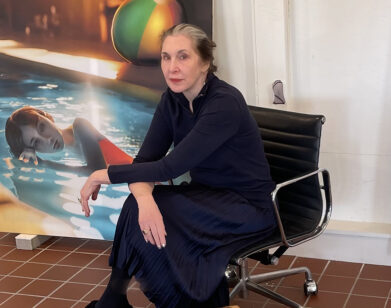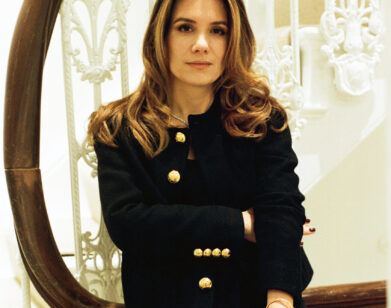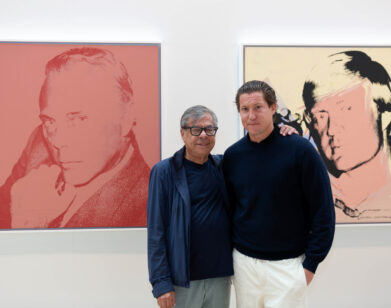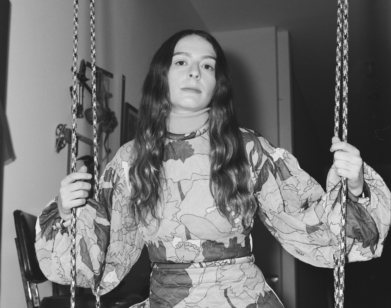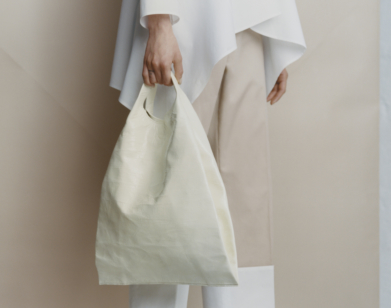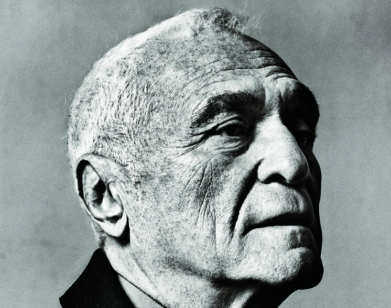IN CONVERSATION
Dorothea Rockburne and Walter Robinson on Sex, Fame, and Mathematics
The sixth-ever issue of Art-Rite, a downtown art magazine published on newsprint by Walter Robinson, Edit DeAk, and Joshua Cohn between 1973 and 1978, featured a limited edition folded cover by the artist Dorothea Rockburne. Exactly 50 years later, Robinson still remembers the piece well. “To me, it’s the essence of a Dorothea Rockburne,” he told the now 95-year-old artist when the two got together in New York City earlier this month. “It was fantastic and I wanted to express my gratitude.” Decades and decades into their illustrious careers, both Rockburne and Robinson are still working steadily. The former, in fact, just headlined the very first European survey of her work at London’s Bernheim Gallery. The Light Shines in the Darkness and the Darkness Has Not Understood It, curated by Lola Kramer and on view through January 2025, showcases dozens of her works completed between the years 1967 and 2013, ratifying Rockburne’s status as one of the 21st century’s most imaginative and cerebral contemporary artists. But fame, she told Robinson, was “never something I wanted.” In fact, she adds, “I’ve avoided it.” Below, she and Robinson, whose collection of art criticism will be published by Edgewise Press early next year, take part in a wide-ranging conversation about their lives and respective artistic practices, touching on everything from their earliest encounters with Robert Rauschenberg and Andy Warhol (“he wanted to know how to be famous”) to the influence of mathematics on Rockburne’s work and the fundamentally erotic nature of artmaking. “Art is sexual,” Rockburne claims, “and that’s very hard to talk about because this is a culture which completely perverts sex, in my opinion.”
———
WALTER ROBINSON: I did my homework before this interview. I reviewed the catalogs for your retrospective at the Parish in 2011 and the incredible show at David Nolan in 2021. After reviewing all that, I feel like you’ve been awfully busy with so many interesting things on your CV.
DOROTHEA ROCKBURNE: You’ve known me for years. I always seem like I’m not doing anything, but I get a lot done. [Rockburne’s cat appears] This is Mr. Mickey Mouse. He’s so sweet.
ROBINSON: You’re a cat person.
ROCKBURNE: Yeah, I’m a cat person. I’m a dog person too.
ROBINSON: I’m a cat person also. Have you ever had dogs?
ROCKBURNE: I grew up with a dog, but they’re too difficult in New York if you’re one person.
ROBINSON: One of my earliest memories is going into the kitchen and asking, “Mom, where’s Snowball? I can’t find her anywhere.”
ROCKBURNE: What a great name.
ROBINSON: “We gave Snowball to the girl down the street because you hadn’t paid any attention to her for three days.” My earliest memory.
ROCKBURNE: Wow, how cruel!
ROBINSON: Now I like cats, because dogs are such hustlers.
ROCKBURNE: They are. Tell me, are you writing a lot? Are you painting a lot?
ROBINSON: I paint a lot. I worked for many years as a writer but I gave it up 10 or 12 years ago.
ROCKBURNE: You were painting when I knew you years ago.
ROBINSON: That’s right, I’ve been painting all along, but now I’ve been doing it full-time. It’s a lot more fun than sitting in front of a word processor. You know what I mean?
ROCKBURNE: Yeah.
ROBINSON: The studio’s filling up with paintings.
ROCKBURNE: When you married one of Tony Smith’s daughters, you raised a child, right?
ROBINSON: That’s right. That was very exciting.
ROCKBURNE: Yeah. What’s the child’s name? I don’t remember.
ROBINSON: Her name is Antonia, named after Tony. She’s 42 now. She has twins. She lives in Richmond. You had one daughter, is that correct?
ROCKBURNE: She’s 72.
ROBINSON: Yeah, she’s my age. Almost—I’m 74. Do you have grandchildren?
ROCKBURNE: No, she never married.
ROBINSON: And you only married one time?
ROCKBURNE: Yeah. I never meant to get married even once, because I didn’t believe in it, but I was pregnant and everybody said, “You’ve got to get married.” But I had relationships that didn’t last.
ROBINSON: Well, you were and are a very beautiful woman.
ROCKBURNE: Thank you.
ROBINSON: I thought I’d start by saying this interview is for Interview Magazine. Have you ever been in Interview before?
ROCKBURNE: No.
ROBINSON: But you probably knew Andy.
ROCKBURNE: Yeah, I did. We liked each other. He hung around Bob [Rauschenberg], who I was working for. He wanted to know how to be famous—you know how direct he was. He decided he wanted to be famous and so he just hung around somebody who was famous.
ROBINSON: I think he was ahead of his time with that. Today, everybody wants to be famous.
ROCKBURNE: Do they? God. It’s never something I wanted. In fact, I’ve avoided it.
ROBINSON: You think?
ROCKBURNE: Well, I didn’t succeed, but I tried.
ROBINSON: I saw that you had a relatively long apprenticeship. You had your first solo show in your low 30s?
ROCKBURNE: No, no. I was really slow.
ROBINSON: But that’s because you took a completely different route.
ROCKBURNE: Well, it’s also because I was supporting a child.
ROBINSON: That’s right. And you worked as a waitress? That’s an amazing skill.
ROCKBURNE: I was the world’s worst waitress. I made a lot of money because I was really cute, but I was a terrible waitress. I even once dumped Eggs Benedict in somebody’s lap.
ROBINSON: Well, that’s good. I hope the person was flirting with you first.
ROCKBURNE: He was. And afterward, too.
ROBINSON: That’s good. Did you get fired because of the Eggs Benedict?
ROCKBURNE: No, no. But I left because I wanted to go away for the summer with my daughter. I wanted to sublet my loft and go to Provincetown. When I tried to come back, they wouldn’t take me back.
ROBINSON: Well, working for artists was better, no?
ROCKBURNE: I didn’t mean to work for an artist, but I knew Bob [Rauschenberg] at Black Mountain [College] and he knew that I was organized. He knew that I would do a good job.
ROBINSON: Did you learn anything from Bob?
ROCKBURNE: Being around Bob was a constant learning curve. Very, very smart man.
ROBINSON: Well, I get the impression you’re pretty smart yourself. I actually wanted to start with this, but I just wanted to thank you again because we asked you to do the cover of the magazine we published, Art-Rite, in 1974.
ROCKBURNE: Yeah, Art-Rite. I folded something.
ROBINSON: To me, it’s the essence of a Dorothea Rockburne. It was fantastic and I wanted to express my gratitude.
ROCKBURNE: Oh, you’re so welcome.
ROBINSON: So your thing is mathematics, folding, dance, and cultural history.
ROCKBURNE: I try to work with materials and let them have their own voice, and part of that voice is mathematics and so on, because things come in units and so on.
ROBINSON: There is a mathematical logic, I think, underpinning most of your works. Which is actually rare among, shall we say, abstract art?
ROCKBURNE: Yes. Well, for some reason, I could imagine, but hardly anybody else can.
ROBINSON: Yes, including me. You were a success from the beginning, I think. The Museum of Modern Art bought from your first show.
ROCKBURNE: Yeah. Who knew?
ROBINSON: Yeah. Well, artists supposedly hold themselves to a high standard. All of us do, supposedly. Except there are a few artists who get by being lazy and uncaring, so that’s always funny.
ROCKBURNE: I have never met an artist who was lazy or uncaring. Always the opposite—overly ambitious motherfuckers and all that. Those ones.
ROBINSON: I think, in a certain way, a lot of people think artists can be very cynical, but I’ve never met an artist who was faking it.
ROCKBURNE: No, me neither.
ROBINSON: They’re all authentic. But I do remember this story about Franz Kline when his mother saw his first show and said, “Oh, Franz, you always take the easy way.”
ROCKBURNE: [Laughs]
ROBINSON: So what should we tell the readers of Interview Magazine? Do you want to emphasize the singular path that women artists had to take, how difficult it was or how different you were than all those macho guys?
ROCKBURNE: No, I didn’t especially feel that way. Historically, what happened was everybody was working on grids and I thought, “How stupid can you get?” And I just started working against the grid, really.
ROBINSON: I’m thinking of the show that was at David Nolan of the sculptures, which were topologically inspired but also had this materiality that was new.
ROCKBURNE: Well, it’s a sculpture of a painter.
ROBINSON: It’s a painter’s idea of a sculpture?
ROCKBURNE: Yeah, a painter’s sculpture, yeah.
ROBINSON: Okay. Have you got any advice for all the youngsters who read Interview Magazine?
ROCKBURNE: Follow your nose.
ROBINSON: Follow your nose?
ROCKBURNE: Yep.
ROBINSON: One thing that I’ve been noticing lately, in the last decade or so, or more, is that painting has really taken over. In the 70s, if my memory serves, there was so much more conceptual, experimental, non-painting type of artworks. And it’s just much rarer today. Have you noticed that?
ROCKBURNE: I’ve noticed that people, but I don’t see any good painting going on.
ROBINSON: That’s right. We could well be in one of those academic periods where there’s no innovation. People are just repeating the familiar formulas. But I like to be more positive.
ROCKBURNE: I haven’t looked around for a long time, but the last time I did, it seemed like there were a lot of English people trying to do figure painting, but they didn’t understand the figure.
ROBINSON: That’s interesting. I know one English figure painter that’s getting renewed attention, Paula Rego.
ROCKBURNE: I don’t know her.
ROBINSON: It’s very physical and bodily, and I think she’s famous for painting women maybe giving birth or having an abortion, I’m not sure. The sort of subjects that men don’t usually typically address.
ROCKBURNE: Yeah.
ROBINSON: Anyway, another thing I picked up from your catalogs was the idea that collage was invented out of disgust at the newspapers, who lied the people into World War I. I never thought that collage had a distinctly political or topical motivation. I thought that was amazing. I wonder if we’ll see a renaissance of collage now during the second Trump administration.
ROCKBURNE: I’m still stunned that he won.
ROBINSON: I know.
ROCKBURNE: I couldn’t believe it. I mean, in New York you’re living in a kind of a womb. You just don’t know.
ROBINSON: I visited some in-laws in North Carolina, and they all have big houses, everybody has a car. And I spent some time at Black Mountain, in the west.
ROCKBURNE: Yeah, in Asheville.
ROBINSON: Black Mountain was a really progressive art school, so I wondered if you had any thoughts on arts education.
ROCKBURNE: I had a very old-fashioned art education. I went to the Montreal Museum School and, I guess as with all education, I really learned a lot from the fellow students that I was studying with.
ROBINSON: You worked side-by-side with all the greats.
ROCKBURNE: Well, they never did art in the normal way. Bob did the white paintings at Black Mountain. Pretty radical. Bob and I played a lot together. We liked each other’s company, so he and Cy [Twombly] and I hung out together a lot, but of course Bob was way ahead of me in his thinking. Although I come from a pretty radical tradition in Montreal, there was a lot of politics going on and the French were rebelling. My father’s French, and so I could never figure out what side of the argument I was on in that particular moment.
ROBINSON: You’re Canadian?
ROCKBURNE: French-Canadian.
ROBINSON: Some of our best artists are from Canada. You’re a student of [Maurice] Merleau-Ponty, right? The great phenomenological philosopher?
ROCKBURNE: It’s true, I am.
ROBINSON: Where do your artistic ideas come from?
ROCKBURNE: I think probably a lot from some principles of mathematics. I didn’t know I could do mathematics. I went through school and I couldn’t do mathematics like everybody else. And then I was at Black Mountain and the teacher was teaching math and I just stood in the doorway and watched him draw on the board for the first time. I was just stunned. It was like the holy grail or something. It’s like, if you look at a star, you know that you know what a star is. I don’t think I was thinking about sublime space or anything. And remember, the education of a woman was very different when I was young. No math or anything.
ROBINSON: What do you think a young artist should do today?
ROCKBURNE: Well, I try to teach. I usually take people one at a time and train them to be an artist. You’ve got to read a lot. And one of the things that I try to talk about is the part of sexuality in art, how it’s a sexual thing. Art is sexual, and that’s very hard to talk about because this is a culture which completely perverts sex, in my opinion. It’s not open and fun. It’s not like two puppy dogs playing.
ROBINSON: Two puppy dogs playing. Do you think art should be like that?
ROCKBURNE: No.
ROBINSON: No?
ROCKBURNE: No, but I think that’s a form of sexuality, one form.
ROBINSON: Right.
ROCKBURNE: When I taught classes, it’s very hard to get the sexual part of people to come forth, like the way a line can be sexy.
ROBINSON: Go on.
ROCKBURNE: I don’t know how to go on.
ROBINSON: I always think that the art enterprise in general is sexual in the sense that the artist is an exhibitionist and the viewer is a voyeur. The artist shows themselves and the viewers take it in. But that’s not exactly what you’re talking about.
ROCKBURNE: No.
ROBINSON: You’re talking about the artist expressing. It’s not really about expressing sexuality either, is it? Like how Hugh Hefner expressed a certain sexuality.
ROCKBURNE: No, he didn’t.
ROBINSON: He did.
ROCKBURNE: He expressed his intimidation by sexual feelings, and he said so. But was it really about sex and having an orgasm and things like that? Wasn’t like that?
ROBINSON: Orgasm is not the part of sexuality you’re talking about.
ROCKBURNE: Well, it’s a part of sexuality.
ROBINSON: I think, in a sense, that biology is so central to everything, and sexuality is central to biology. I could see it that way.
ROCKBURNE: Yeah.
ROBINSON: That’s so interesting. That’s what I thought when I saw the sculptures at Nolan, they reminded me of the metaphysical constructions of Joseph Beuys.
ROCKBURNE: Wow, thank you.
ROBINSON: But those I couldn’t read as symbolic in a way, and I’m not sure much of your work reads as symbolic.
ROCKBURNE: No. It’s not easy to put language to non-linguistic experiences.
ROBINSON: Do you like to listen to music while you work?
ROCKBURNE: It depends. Sometimes, I listen to music while I work, but then I tend to turn it off.
ROBINSON: Do you have a variety of taste in music? Do you prefer hot jazz?
ROCKBURNE: I follow the person playing the instrument, particularly pianists.
ROBINSON: That’s why I like watching football—the skill and precision of the players is on full display.
ROCKBURNE: Football is a very intellectual and difficult game to follow.
ROBINSON: Many sports showcase exceptional skill.
ROCKBURNE: Growing up in Canada, you do fantastic sports. At six, I could ski off a hill, do a somersault, and land.
ROBINSON: Did you play hockey too?
ROCKBURNE: Yes, I was a goalie in grade school. It was hard. But I had extensive physical training in skiing and swimming. Our lake was five miles long, and I swam across it every summer until age 14.
ROBINSON: You studied music with John Cage at Black Mountain College, right?
ROCKBURNE: Yes, he taught a class on music, sound, and silence. It was hard to go to bed at night with so much happening, going from one wonderful class to the next.
ROBINSON: What makes a dream art dealer?
ROCKBURNE: Klaus Kertess was the dream. He appreciated beauty and wanted extremes. John Weber was crazy and stupid, inheriting Virginia Dwan’s artists.
ROBINSON: I remember seeing Mel Bochner’s work at Weber, with taped squares and pennies on the floor. My presence trying to figure it out felt like part of the work.
ROCKBURNE: The viewer viewing the work completes it by the act of viewing.
ROBINSON: An ideal aesthetic experience is like being smitten by someone—it’s irrational but powerful.
ROCKBURNE: I’m always smitten by Barry Le Va’s work, like the white chalk shapes on the floor. My viewing and understanding complete the work.
ROBINSON: Barry briefly dated my sister-in-law, Kiki Smith, but his alcoholism was too much.
ROCKBURNE: I remember that well. Kiki shouldn’t have put up with it.
ROBINSON: I remember Klaus. He was elegant and formidable.
ROCKBURNE: It wasn’t obvious Klaus was gay at first. Remember, he dated Lynda Benglis for a while.
ROBINSON: Wow, I didn’t realize. Do you still have close artist friends?
ROCKBURNE: David Rowe is a good friend.
ROBINSON: I love David.
ROCKBURNE: He’s a very good artist.
ROBINSON: I can see an aesthetic relationship. What about Mel Kendrick?
ROCKBURNE: Mel Kendrick is a very good artist too.
ROBINSON: I was pleased to meet his son, Max, who looks just like him. What about your friendship with Fred Eversley?
ROCKBURNE: Fred and I have known each other for about 25 years. He was part of the light movement group from the West Coast.
ROBINSON: He just got a big commission in Palm Beach, Florida. And what about Mimi Gross?
ROCKBURNE: I’ve known Mimi a long time, but we’ve never been close. Her mother was marvelous.
ROBINSON: Mimi is the daughter of Chaim Gross, the famous Jewish sculptor. She has a foundation on LaGuardia Place. Lucinda Childs is still with us at 84. Did you hang out at Max’s Kansas City back in the day?
ROCKBURNE: Of course, everyone was there. The owner Mickey Ruskin really liked artists and wouldn’t let non-artists in. There are no affordable watering holes for artists anymore.
ROBINSON: My wife Lisa was born on 106th and Broadway. We met on the dance floor at The Mudd Club in the ’80s when she was 19 and I was 30. Mickey would let artists run tabs. He was a real guiding light.
ROCKBURNE: When’s your next show, Walter?
ROBINSON: As soon as we can arrange it. I offer people artworks to get them to visit my studio, but even when it’s free they don’t come. As Hans Neuendorf used to say, “Throw it out the window and it comes walking back in your door.”






